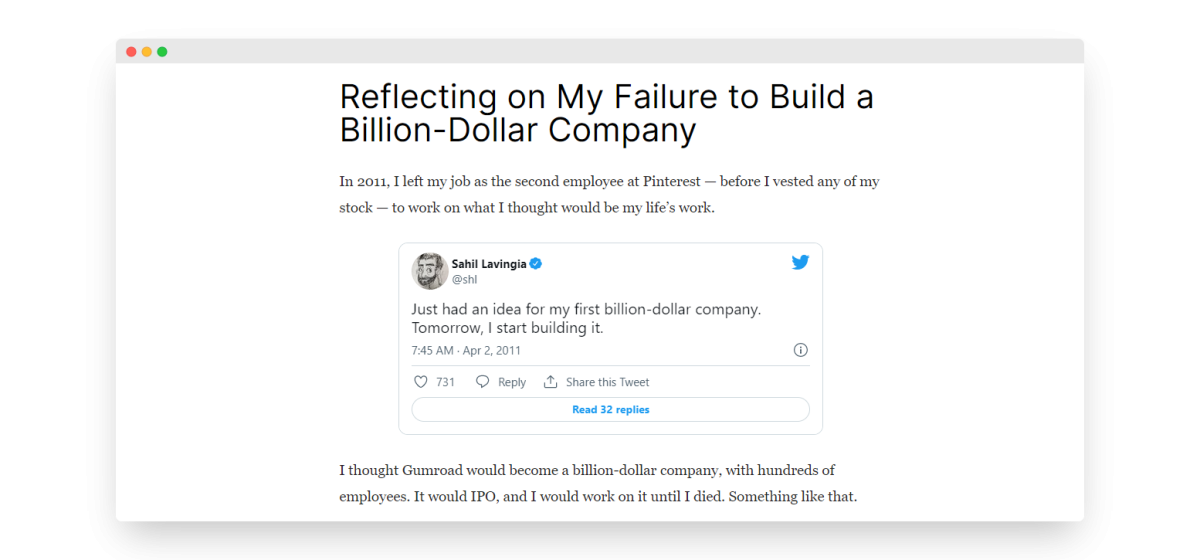What do Will Smith, Megan Rapinoe, and Gucci Mane have in common? Besides being masters in their respective fields, they were all savvy and humble enough to recognize that their life stories would sound better (and sell better) if they entrusted them to a professional writer.
Yes—I’m talking about the mysterious, misunderstood practice of ghostwriting.
One literary agent estimates that at least 60% of nonfiction books are penned by someone whose name doesn’t appear on the front cover. But ghostwriters aren’t just for wealthy celebrities with lucrative publishing deals; they’re a vital resource for executives who need their ideas to resonate in the era of infinite content.
You might argue that shouldering the load of thought leadership is a noble undertaking for someone in the C-suite. I’d argue it’s a mistake.
I’ve written articles and books on behalf of architects, entrepreneurs, and executives at publicly traded companies—the common thread through those experiences was that the clients were better at generating ideas than distilling them into prose. If they attempted the latter, the end product would’ve wound up unfinished, confusing, or worst of all … boring.
The operative question about ghostwriting, then, isn’t“How much does it cost?”—it’s “What’s the cost of sharing half-baked, amateur ideas for the whole world to see?”
(Or equally problematic, no ideas at all?)
Publishing Your Ideas Isn’t Optional
Sharing compelling, original insights on your blog or another byline is no longer a nice-to-have for today’s founders and executives. It’s essential for building a community, establishing trust, and distinguishing your brand.
Take Sahil Lavingia, the founder of Gumroad, for example. He could have easily built his company in silence. Instead, he pulled back the curtain in his essay “Reflecting on My Failure to Build a Billion-Dollar Company,” in which he opened up about Gumroad’s financial struggles, laying off 75% of his team, and building back into one of the most successful online selling platforms. That piece showcased Sahil’s entrepreneurial chops—but more importantly, it was a magnet for readers who craved raw honesty about what it takes to build a business.
As of today, that single essay has well over a million views and still generates discussions on Twitter—even after nearly two years. Talk about compound interest.

Sahil’s steady drumbeat of insights and observations has cultivated a community of more than a quarter-million engaged followers on Twitter, which serves as an indirect conversion mechanism for Gumroad. Not to mention, he parlayed his authority into a book deal with a Big Five publisher (The Minimalist Entrepreneur, which came out in October 2021).
Another stellar example is Brendan Schwartz, co-founder and CTO at Wistia. Brendan frequently translates Wistia’s successes and struggles into thoughtful, provocative articles, like this one reflecting on why setting ambitious goals backfires. These types of stories transform just another video platform into a living, breathing entity of real people. They put Wistia’s values and beliefs (and the people acting them out) front and center—and that’s what builds trust with customers, partners, and even employees.

Sharing bold, nuanced ideas is important, but that doesn’t mean you have to embark on that journey alone. In fact, you probably shouldn’t. Contrast Sahil and Brendan with “thought leaders” who write a few 200-word LinkedIn articles that sound something like “5 Reasons You Need [Product We Sell]” or “3 Predictions About [Industry] for Next Year.” Without a helping hand—someone to water-test your ideas, punch up your prose, and home in on contrarian angles—it’s easy for thought leadership to miss the mark.
You’re Not a Writer, You’re an Expert
Some executives are naturally inclined to expression through writing. They find it fulfilling, even easy. But what if you aren’t in that camp? Should you miss out on the benefits of thought leadership just because you’re a better leader than you are an editor? Enter ghostwriters.
One uncharitable idea is that public figures retain ghostwriters because they can’t string a few sentences together. That’s rarely the case—at least in my experience. They have ghostwriters because of the simple economic reality that their time is better spent growing a brand than writing about growing a brand.
“Their time is better spent growing a brand than writing about growing a brand.”
Your expertise may lie in solving complex problems, navigating a tricky industry, or forging key relationships. It probably doesn’t lie in your ability to find a narrative angle that hasn’t been exhausted, to snare attention with a clever hook, or use Hegelian dialectic to persuade readers.
And yet, many executives still feel pressure to white-knuckle their way to readable articles. You know these when you see them: the logic breaks down halfway through the piece, they slip into passive voice, and the same points get rehashed with different combinations of words.
In an age where jam-packed schedules are converging with an insatiable demand for content, delegating thought leadership to a professional offers peace of mind and a better end product.
The Ghost(writer) in the Machine
Chances are you’re sitting on a goldmine of ideas; now you need help to extract them and translate them into prose. Here’s how to make the most of working with a ghostwriter:
Turn the Tap of Idea Generation
I’ve worked with clients who come to our first meeting with a lengthy list of topic ideas. Other times, figuring out what to write is our biggest obstacle. If you fall into the latter camp, here are a few questions to ask yourself:
Do you have a valuable personal experience that few others have?
What are the 2–3 things that annoy you about your industry?
Do you have proprietary data that lends itself to an interesting story?
Have you had any lightbulb moments in sales meetings, Slack channels, or Zoom calls?
What advice would you give yourself 1, 5, or 10 years ago?
If all else fails, take Ryan Holiday’s advice: “The best things to write are the things you’re afraid to talk about.”
Build Trust With Your Ghostwriter
In my experience, this is usually the most neglected step—understandably so. You’re champing at the bit to crank out content immediately, but like any working relationship, you and your ghostwriter need to build trust and align on your goals.
I like to start with a conversation without any agenda, notes, or recording devices. This lowers the stakes and establishes rapport. Once we’re both comfortable, I usually request a writing brief that outlines the scope of the engagement, including expected word count(s), budget, stylistic preferences, and so on.
Personalize the Ghostwriting Process
The degree of involvement clients have with ghostwriters varies drastically. I’ve worked with people who send me a few bullet points and give me free rein. Other times, they want to speak with me for hours and write collaboratively. There isn’t a right or wrong approach here. It usually comes down to whether you’re a big-picture thinker or particularly detail-oriented.
Regardless, it’s essential that your ghostwriter captures your voice rather than assigning you one. To accomplish this, I start by consuming any content my client has already produced: podcasts, talks, tweets. This helps me pick up their idiosyncrasies, vocabulary, and tone that I simply can’t get by diving straight into a first draft.
In the initial stages of a ghostwriting engagement, I like to share early drafts with people who know the author well (with their permission) and ask two questions:
Does this make sense?
Does this sound like [NAME]?
Third-party feedback is one of the fastest ways to accelerate the ghostwriting learning curve. After a month or so, I have a fingertip feel for the client’s voice. In fact, l feel less like a ghostwriter and more like an extension of their brain.
Doers Shouldn’t Double as Chroniclers
Last year, I met with the founder of a venture-backed SaaS company who wanted to publish a series of articles about his backstory and mission. He had a few rough drafts but needed help punching them up. But when I opened the Google Doc, I realized his ideas were on life support. We had to go back to the drawing board.
I worried he might take my suggestion personally; instead, he was relieved. “I know, I know,” he said. “I’ve just been so swamped that I haven’t been able to give these ideas the attention they deserve.”
Case in point. We get it—there’s a ton of pressure to publish articles and books that make onlookers wonder, Why didn’t I think of that? If you’ve made it this far, you now know that talented ghostwriters are behind a good chunk of that content, bridging the difficult, time-consuming gap between great idea and great writing.
Some call it a dirty secret. I call it supply and demand.
